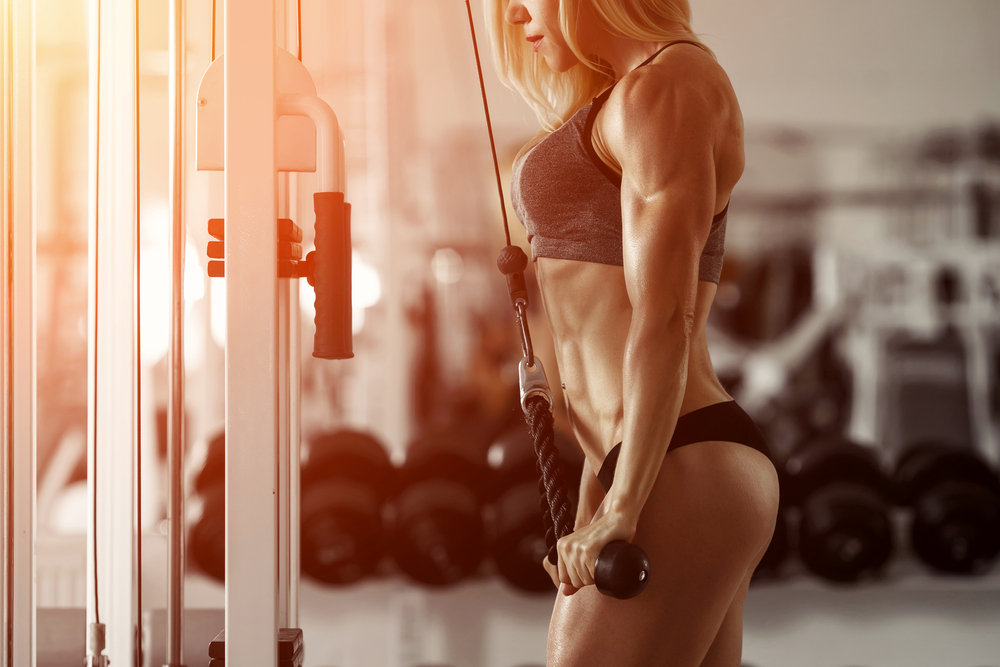- Breast implants within the bodybuilding, physique, figure and bikini divisions are widely accepted and very common.
- Choosing to have your implants placed above the muscle will have the least impact on your ability to train, but also results in a less natural look.
- Choosing to have your implants placed below the muscle severely limits your ability to ever truly develop your pectoral muscles.
- The more rigorous the training, the more likely you’ll require multiple repair surgeries.
- Breast implants have been associated with a variety of negative symptoms in some patients that only dissipate after explanting.
Losing a significant amount of fatty breast tissue is inevitable for most women training to compete in bodybuilding, physique, figure or bikini divisions in the overall sport of bodybuilding.
If you’re a female bodybuilder, here’s what you need to know before undergoing breast enhancement surgery.
Why Are Implants So Common Among Bikini Competitors?
While some bikini competitors are able to maintain a small amount of breast tissue, it’s very unlikely for women competing in bodybuilding, physique or figure since their body fat percentages must be very low to stay competitive.
Because the sport so commonly leads to flat chests, breast implants within all of these divisions has become very common. For some, the pressure to get implants in order to balance out the overall female figure is unspoken but clear.
“It’s not a prerequisite,” explains Rachael Oberst, a Bikini IFBB Pro and posing instructor with Andrew Berry, from Vermont, “but it does help your overall look when you have them. If there are two girls with the exact same body type, the one with implants is probably going to win.”
Oberst says she’s seen competitors in the IFBB Pro divisions without implants, but the majority do have them—creating a self-imposed pressure.
“You look around during a competition, and everyone has them. It’s become a sort of expectation within the culture of the sport.”
Breast Enhancement Surgery In Bodybuilding: Different Opinions
In bodybuilding and physique divisions, where breast tissue easily becomes nonexistent and the muscular figure begins to take on a traditionally more masculine appearance, breast implants are equally part of the culture but not required for success.
“It’s still a personal choice,” explains Colette Nelson, a physique IFBB Pro from New York. “More women in the sport these days, like Dana Lynn Bailey, a physique IFBB Pro, do not want implants. They prefer the look of a muscular chest without implants, and they find that implants just get in the way of training.”
Instead, Nelson says she’s actually seeing the number of women in the physique and bodybuilding divisions saying no to implants and opting for a more natural look.
“That being said, this is a sport about aesthetics and proportions,” adds Nelson. “Some women simply want to accentuate their femininity and there is no better way to do that than by getting implants. When you work out five to six hours a week in the gym on building your muscles to shape a well-proportioned physique, you have a limitation, and that is breast tissue.”
But one shouldn’t assume that just because these female competitors appreciate the look of abundant muscle doesn’t mean they don’t also appreciate the naturally feminine aspects of their body.
“The loss of breast tissue can be very emotional for some women, and they feel strongly about completing their look with implants,” adds Nelson.
Nelson had wanted breast implants long before she ever pursued bodybuilding, but the acceptance of implants within the bodybuilding culture made it feel less taboo.
“When I started bodybuilding, it gave me the courage to get it done. I probably wouldn’t have otherwise had the guts to do it. Bodybuilding gave it more meaning for me—it wasn’t just my desire for larger breasts anymore. Now it’s part of maintaining a well-proportioned physique.”
Looking Closely at Why You Want Implants
“I’d always wanted breast implants, since the fifth grade,” explains Oberst, “but I waited until I knew I was in a good place with my relationship with my fiancé, when I was physically and mentally in a good place, and I was in a solid place financially. I didn’t look at implants as a way to change who I am. I didn’t need to increase my confidence level or my self-esteem. If you’re not in a good place with who you are, you should wait.”
When you first begin thinking about implants, Oberst suggests waiting at least six months before moving forward with the decision. She then recommends doing your research for a few months; don’t rush into scheduling surgery.
“I spent a lot of time researching and reading about risks, types of implants, why some people regret getting them, and what the surgery and recovery is like,” explains Oberst.
The most common reason many women regret getting implants seemed to be directly related to struggling with low self-esteem prior to surgery.
“That was most of what I came across in my research on why some women have regrets,” Oberst cautions. “Don’t go into this expecting that you’re going to like yourself better just because of implants.”
Oberst found the majority of negative experiences in online forums about implants were from women who made the decision too quickly, weren’t happy with themselves in general, and thus got implants for psychological and emotional reasons rather than for the visual aesthetic.
“I didn’t see myself in of those women’s comments, which helped assure me I was ready,” says Oberst. “Make sure you’re comfortable in your own skin before you even think about getting implants. Work on yourself first. Breast implants can’t fix insecurity and self-esteem issues.”
The Right Type of Surgery: Above or Below the Muscle?
Deciding whether you want your implants placed above or below the muscle is based primarily on two factors: appearance and future training limitations.
While the appearance looks far less natural, having your implants placed above the muscle means your recovery time is much shorter, and most importantly, your training in the gym is only limited for a few weeks while you heal.
For competitors in the bodybuilding, physique, and figure divisions this can be a crucial detail because building and maintaining your pec muscles will be essential to your training programs, future competitions, and overall muscular development.
“I chose to have mine placed above the muscle,” says Nelson. “The recovery is about two weeks, and you can train exactly the same as you did before. There’s no difference. I’ve known a few powerlifters with implants over the muscle who are benching over 400 pounds.”
The other option—below the muscle—paints a much different picture.
Choosing to have your implants placed below the muscle results in a more natural appearance, but many surgeons suggest you avoid training your chest ever again.
While it is physically possible to do some chest training with implants placed below the muscle, it’s risky and needs to be done very carefully. Heavy lifting is definitely out of the question. Any intense pressure or strain on the muscle in the chest area can actually move the implant or even cause it to rupture.
“I have bodybuilding friends who had their implants placed under the muscle, and they still train their chest, but for some of them, their implants were pushed into their armpits from training too heavy,” cautions Nelson.
Whether you choose above or below, Nelson says it’s very common in the bodybuilding and physique business to need your implants done anywhere from three to six times for repairs, largely due to frequent and heavy training.
As a bikini competitor, Oberst says the choice was easy: below the muscle.
“I don’t need to develop my pecs to stay competitive,” explains Oberst. “I still do a couple of exercises that do engage those muscles, but my focus in those exercises is for my front delts, not my pecs. And I’m really careful with the weight and intensity.”
Oberst says for bikini competitors and the average woman, not being able to do push-ups or the bench press is no big deal.
Below the muscle placement looks much more natural, and is definitely ideal for bikini competitors for whom developed pec muscles simply aren’t necessary.
Saline, Silicone, or Gummy Bear?
Making the decision between round saline, round silicone, or gummy bear implants is not as simple as you might think.
- Round silicone implants
Silicone implants are said to have the most natural look and feel. Unlike saline implants, which can feel rather hard, silicone implants maintain a softer, more flesh-like feel. Both types of breast implants have proven to be safe in numerous studies.
The biggest drawbacks to silicone implants is their cost, which can be twice the amount of saline-filled implants. Furthermore, the silicone filling of silicone implants cannot be absorbed by the body in case of rupture, and must be removed in many cases.
- Gummy bear implants
The newest and most popular type of implant on the market is the gummy bear implant.
“I have gummy bear implants,” explains Oberst. “The surgeon I went to in New York is the leading surgeon in the country on this type of implant. It also seemed like a lot of women were turning towards wanting to get them because they feel more natural and realistic, with a 1% rupture rate.”
Unlike saline, you won’t wake up and discover one of your implants has ruptured, making it look like half of your chest has deflated. This is not uncommon.
Among athletes specifically, gummy bear implants are becoming more popular because it’s assumed they cannot leak into the body if they rupture—and considering an active lifestyle might increase the chances of a rupture, this makes them a logical choice.
However, Knoxville, TN plastic surgeon Dr. David B. Reath cautions against believing gummy bear implants are 100% safe, and says that the name is misleading.
“Recently, in the operating room, I had the occasion to remove a set of these implants. Being curious, at the end of the case, I cut into one of them. Honestly if I had not known that these were highly cohesive gel implants (fifth generation), I would have thought that they were just regular cohesive gel implants (fourth generation) because inside the shell was a semi-solid, viscous silicone gel, that looked and acted just the same.”
“The gummy bear implants are not solid,” explains Dr. Reath. “The gel in these implants is more cohesive than the others, but not as solid as the moniker gummy bear might imply.”
In other words, gummy bear implants can leak their contents into your body just like any other saline or silicone implant. While “newer” may be more appealing, that does not mean they are safer, and they’re also more expensive compared to saline and silicone implants.
- Saline implants
Saline implants consist of a silicone shell that is filled with a sterile saltwater solution after it is inserted. Said to look and feel the least natural, women tend to choose a saline implant because they are the least expensive of all three options, and they are thought to be safer if they were to rupture and leak into the body.
Choosing the Right Shape and Size
“First, I looked at a lot of pictures online of girls in different forms of clothing (bikini, T-shirts and sports bras) with different breast sizes to figure out how big I wanted them to look on my body,” explains Oberst. “It was more about finding the proportion that I wanted, not any specific cup size.”
Oberst also talked to her friends with implants about their own cup size decisions.
“I went with a DD size, and I’m happy with the size I went with,” says Oberst. “I wanted implants that looked more natural, a ‘Did she get them? Did she not?’ kind of look.”
For a bodybuilder, DD-sized breasts can easily look very small, whereas a DD cup size on the average female body usually looks large.
“A lot of my friends wish they had gone bigger,” says Nelson.
In the bodybuilding world, the consideration of proportion vs. cup size, as Oberst suggests, may be a crucial difference when choosing the right size for you.
Choosing a size that your frame can physically support is also less of a factor for athletes because they have the physical strength to support a larger breast size.
For a female bodybuilder, a G cup size may look proportionate to her overall muscular frame and it’s safe to assume her body can handle the added weight, too.
With compound movements becoming more popular among every day female athletes in sports like CrossFit, Nelson does point out that having implants won’t make you a better athlete. They can simply get in the way, cause you to be less agile, and even impede your speed as a runner.
Preparing for Surgery
Not only will your training be impacted after your surgery, but for those choosing to have their implants placed under the muscle you’ll be better off if you also stop training your chest in the weeks prior to surgery.
“I stopped training my chest about two months before going in,” explains Oberst. “If you go in with a ton of muscle-—especially if it’s tight and sore from recent training sessions—it’s going to be hard for them to actually fit in the size of implant you chose.”
Oberst purposefully gave her chest muscles plenty of time prior to surgery to ensure they were relaxed and even a bit atrophied to enable a successful fitting of the implant size she had selected.
For those choosing to have their implants placed above the muscle, there is no need to alter your presurgery training regimen.
How Breast Augmentation Will Impact Your Training Regimen
The first week after surgery, you’ll likely find you need a couple of days to simply sleep as much as possible.
When trying to sit up in bed, Oberst says she was surprised at just how painful it was due to the significant use of upper body muscles in those types of everyday movements.
By the fourth day postsurgery you can expect to be back at work, and perhaps take a very short stroll in the neighborhood with your dog—but hopping on the treadmill for some cardio is out of the question.
“I didn’t start exercising until after eight weeks,” says Oberst. “The recommended time off from all exercise was four to six weeks for cardio exercise, and six to eight weeks for any weightlifting—but no lifting for your chest muscles.”
For women whose lives usually revolve around training schedules and everyday exercise, avoiding the gym for two months could be challenging, but it’s crucial.
Oberst suggests approaching weightlifting very cautiously—and avoiding training your upper body for as long as possible.
“When you’re spending over $6,000 on your body, why would you want to screw that up?” asks Oberst. “You have to take plenty of time off to make sure everything heals properly. I’ve seen what implants look like on people who started lifting too soon after surgery. You can tell. They shift around and they just don’t look good.”
At 10 weeks postsurgery, Oberst started training with weights, but only lower body exercises. And she kept the weights lighter than she knew she could actually handle.
“I built back up to my previous workout really slowly, over the course of three to four months. If it didn’t feel right, or I felt out of breath, I would stop or slow down.”
As described earlier, your training regimen will not be limited at all if you choose to have the implants placed above the muscle. After giving your body six to eight weeks for healing, you can return to your normal lifting regimen.
Women who receive below the muscle implants are usually advised to never train their chest again, although it is doable—but you must be cautious and mindful. For some, exercises such as pull-ups and push-ups may be unachievable even years after surgery, so it’s important to rethink how different your training will be even after you’re fully recovered.
“My nurse for my surgery was a former figure competitor. She told me to wait awhile, but that I’d be able to train my chest again. It really depends on who you talk to,” says Oberst.
Exercising caution, Oberst says she didn’t train her chest at all for a full year after her surgery.
If there’s ever a crucial time in your life to be “lazy” in the gym, it’s when you’re allowing your breast implants to heal fully and properly.
Potential Risks and Complications
For athletic women, the biggest concerns and risk with implants is a rupture, capsular contracture, or dramatic movement of an implant.
“Implants come at a price,” says Nelson, “and as a fitness athlete you can expect to be having your implants surgically fixed two to six times within the first 10 to 15 years due to issues with movement, capsular contracture, rippling, shifting in the pocket, etc.”
Keeping this in mind is what motivates Oberst to be very cautious in the gym, but as a bikini competitor she can also minimize these risks because training her chest simply isn’t necessary.
For Nelson, the development of her pecs is a critical aspect of who she is (since a bodybuilder maintains muscle mass), but she’s had to endure some incredibly tedious and costly complications in order to maintain her implants.
“I’ve personally had mine done eight times,” says Nelson, “and three of those were due to breast cancer scares.”
During a mammogram, Nelson’s doctors found what they thought was a potential lump in her breast tissue. With a family history of breast cancer, she went ahead with the removal of the lump and fortunately learned that it was just scar tissue from her implant surgeries.
The surgery to remove the suspicious lump, however, resulted in a seroma—a pocket of fluid—beneath her implant, causing the incisions to open up and leak.
“It was a horrible experience,” says Nelson, “and they had to remove my implants. I was without them for almost a year, then when they were put back in, they didn’t look right. I had to have them redone a year later. It was truly a nightmare experience.”
Despite the ordeal she’s been through, Nelson says it’s worth it.
Illness and Symptoms Associated with Breast Implants
While many women are happy with their implants for years to come, it’s important to keep in mind that there is an ever-growing community of women and surgeons promoting the removal of implants due to related implant toxicity and illness.
The FDA has not commented specifically on reports of “breast implant illness,” and has stated that breast implants are reasonably safe and effective when used properly.
Nevertheless, several groups have been formed by and for women claiming that their breast implants have led to health problems.
Healing Breast Implant Illness is an organization actively working to educate patients with implants on the potential long-term side effects of these “toxic bags”—so-named after being associating with a long list of complications and side effects that only resolve themselves after the implants have been removed during an “explant surgery.”
A long list of conditions and symptoms associated with implants that are believed to occur in many patients within a few years or beyond a decade, including chronic fatigue, muscle pain or weakness, inflammation, and more.
If you choose to get implants, inform yourself of these possible side effects. If, after surgery, you experience any of these symptoms, discuss them with your doctor immediately. There are a series of recommended tests you can request to help determine the cause behind your symptoms and if your implants are negatively impacting your overall well-being.
While implants are a very understandable choice for the athletic woman struggling to maintain any of her own natural breast tissue during intense training and low body fat levels, the decision to get implants should be carefully contemplated and thoroughly researched.









